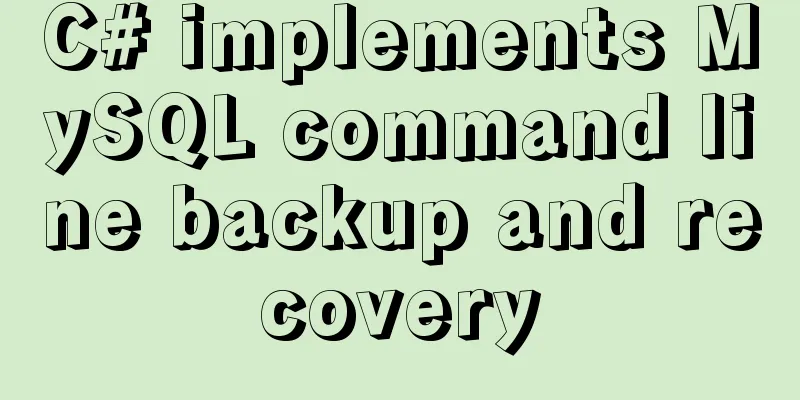C# implements MySQL command line backup and recovery

|
There are many tools available for backing up MySQL databases. In the past two days, I wrote a small tool that uses C# to call MYSQL's mysqldump command to complete the backup and recovery of MySQL databases. Let's first talk about how to use the mysqldump command to back up the MySQL database. mysqldump -hhostname -uusername -ppassword databasename > backupfile.sql Compress and back up the MySQL database directly mysqldump -hhostname -uusername -ppassword databasename | gzip > backupfile.sql.gz Back up a table(s) in the MySQL database mysqldump -hhostname -uusername -ppassword databasename specific_table1 specific_table2 > backupfile.sql Back up multiple MySQL databases simultaneously mysqldump -hhostname -uusername -ppassword –databases databasename1 databasename2 databasename3 > multibackupfile.sql Back up only the database structure mysqldump –no-data –databases databasename1 databasename2 databasename3 > structurebackupfile.sql Back up all databases on the server mysqldump –all-databases > allbackupfile.sql Command to restore MySQL database mysql -hhostname -uusername -ppassword databasename < backupfile.sql Restoring a compressed MySQL database gunzip < backupfile.sql.gz | mysql -uusername -ppassword databasename Transfer the database to the new server mysqldump -uusername -ppassword databasename | mysql –host=*.*.*.* -C databasename Using C# to operate MYSQL backup and recovery is mainly achieved by using C# to execute external programs Below is some C# source code
/// <summary>
/// Back up the database to a specific directory/// </summary>
/// <param name="binfolderpath">Bin folder directory, used to get the mysqldump.exe file</param>
/// <param name="server">Server</param>
/// <param name="user">User name</param>
/// <param name="pass">Password</param>
/// <param name="db">Database name to be backed up</param>
/// <param name="backupfile">What file to back up to</param>
/// <returns></returns>
public static bool BackupDB(string binfolderpath, string server, string character, string user, string pass, string db, string backupfile)
{
string command = string.Format("mysqldump.exe --quick --host=\"{0}\" --default-character-set=\"{1}\" --lock-tables --verbose --force --port=3306 --user=\"{2}\" --password=\"{3}\" \"{4}\" -r \"{5}\"",server, character.Trim().ToLower(), user, pass, db, backupfile);
StartCmd(binfolderpath + @"\", command);
if (File.Exists(backupfile))
{
return true;
}
else
{
return false;
}
}
/// <summary>
/// Restore the specified database to the specified file/// </summary>
/// <param name="binfolderpath">Bin folder directory, used to get the mysqldump.exe file</param>
/// <param name="server">Server</param>
/// <param name="user">User name</param>
/// <param name="pass">Password</param>
/// <param name="db">Database name to be backed up</param>
/// <param name="backupfile">SQL file to be restored</param>
/// <returns></returns>
public static bool RestoreDB(string binfolderpath, string character, string server, string user, string pass, string db, string restorefile)
{
string command = string.Format("mysql.exe --host=\"{0}\" --default-character-set=\"{1}\" --port=3306 --user=\"{2}\" --password=\"{3}\" \"{4}\"<\"{5}\"", server, character.Trim().ToLower(), user, pass, db, restorefile);
StartCmd(binfolderpath + @"\", command);
return true;
}The database backup and recovery function can be implemented with just a few lines of code. The main principle of implementing MySQL command line backup and recovery in C# is to use C# to execute external programs. There are other implementation methods. You can learn more about them. You may also be interested in:
|
<<: Detailed explanation of several ways of communication between Linux user state and kernel state
>>: How to use module fs file system in Nodejs
Recommend
How to gracefully and safely shut down the MySQL process
Preface This article analyzes the process of shut...
Three ways to communicate between Docker containers
We all know that Docker containers are isolated f...
Detailed explanation of three solutions to the website footer sinking effect
Background Many website designs generally consist...
CentOS installation mysql5.7 detailed tutorial
This article shares the detailed steps of install...
Detailed explanation of vite2.0 configuration learning (typescript version)
introduce You Yuxi’s original words. vite is simi...
JS ES6 asynchronous solution
Table of contents Initially using the callback fu...
Example of Vue transition to achieve like animation effect
Table of contents Results at a Glance Heart Effec...
MySQL 5.7.13 installation and configuration method graphic tutorial (win10 64 bit)
This article shares with you the graphic tutorial...
Play and save WeChat public account recording files (convert amr files to mp3)
Table of contents Audio transcoding tools princip...
50 Super Handy Tools for Web Designers
Being a web designer is not easy. Not only do you...
Detailed explanation of CSS elastic box flex-grow, flex-shrink, flex-basis
The functions of the three attributes flex-grow, ...
A brief discussion on the lazy loading attribute pattern in JavaScript
Table of contents 1. Introduction 2. On-demand at...
Example code of html formatting json
Without further ado, I will post the code for you...
Correct use of Vue function anti-shake and throttling
Preface 1. Debounce: After a high-frequency event...
Example of how to build a Harbor public repository with Docker
The previous blog post talked about the Registry ...









